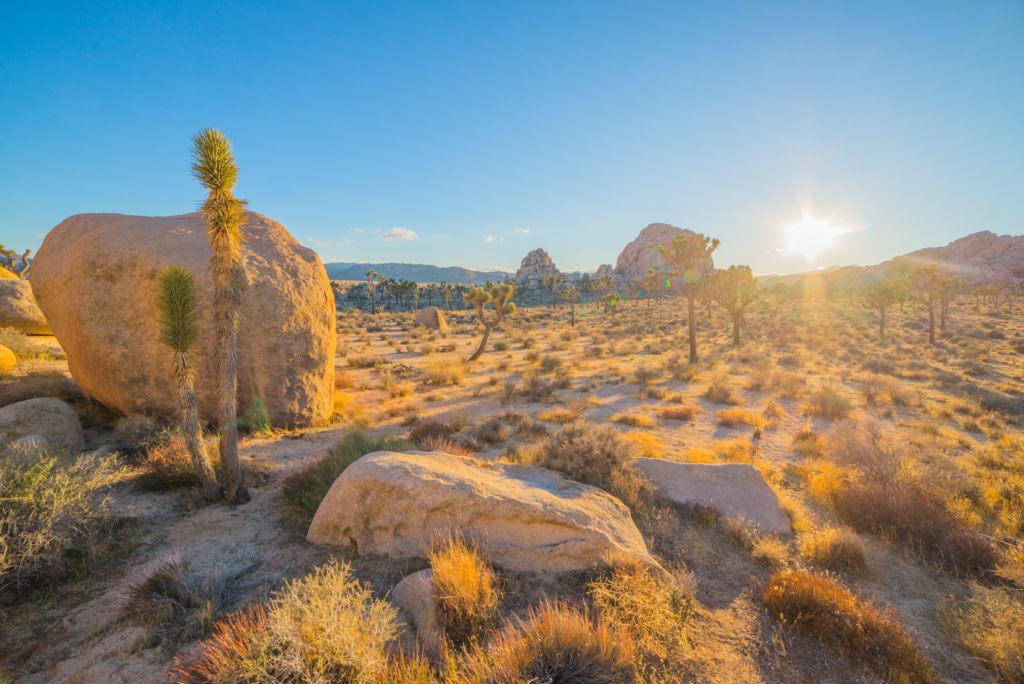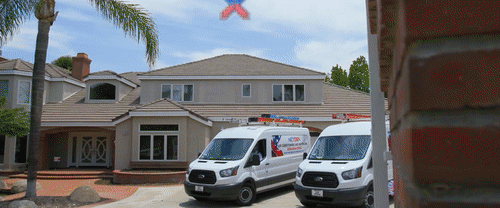AC Performance In Extreme Heat

Central air conditioning systems are designed to suit the size of your home and the amount of air it needs to cool or heat. The size of the specific AC unit, the condenser, is chosen to be efficient for 98% of the typical high temperatures in your area (climate). So for that 2% extreme, like we are having this summer in Palm Desert and Palm Springs, your AC system may actually be undersized. But this is by design. Otherwise, if you went with a larger system that had no trouble pumping the volumes of cool air needed during these extremely hot days, your system would be quite inefficient 98% of the time. And that’s really, almost all the time – not a good thing.
The larger system costs more to install and it consumes more energy to run, all costing you more money. Because it pumps more air volume it cools the house much faster. You might think this was a good thing but instead it means the system is running through off and on cycles at a much higher rate. The shorter cooling cycles means it is not quite running long enough to be pulling humidity out of your home. Removing humidity is part of how an air conditioner works. The condensing coil condenses water out of the air and the heat exchange process during that activity is what creates the cooler air. Warmer air and moisture is then exited from your home. Dryer air, even when warmer, is more comfortable for the human body as it allows our own biological air conditioner, our sweat, to be more efficient. Not removing sufficient humidity from your home could also lead to mold problems.
These are some of the reasons an over-sized AC system is just an all around bad idea. But you can still make the system you have work for you in these 100+ degree conditions.
Getting More Efficiency Out of Your AC System
To make it easier for your AC system to reliably pump out cool air when it’s over 100 degrees outside you need to give it some help.
In a nutshell it comes down to reducing heat gains in the home. Some of the basics are;
- turn the thermostat up a couple degrees and be happy with 76 to 78 degree temperatures indoors
- close off unused rooms – close doors and vents – don’t cool what you don’t use
- shade your windows on the sunny side of the house
- cook outdoors – enjoy the summer BBQ
- don’t use dry cycle on dishwasher – leave door open and let them air dry
- don’t run clothes dryer during the heat of the day
Anything you can do to keep the house stay cooler, even a little bit, means the AC does not need to be running as long for each cooling cycle.
AC Maintenance is Key!
Your central air system should be getting a maintenance check-up at least once a year. Ideally the AC unit should be checked before peak demand during Palm Desert's summer heat, to ensure it’s running at its best when you need it most. It will be running hard through these multiple 100+ degrees days and may even need a check-up later on after all that heavy use.
Call NexGen HVAC & Plumbing
Our expertise and commitment to customer satisfaction make us the leading HVAC company in Southern California. To learn more about our equipment, services, and protection plan, book an appointment online or call 888-277-0415.
Is Your Landlord Responsible for Your AC?

During sweltering summer days air conditioning can seem like it is a necessity. While a good air conditioner can make your rental unit a much more comfortable place to be during the summer is it legally required in California?
Habitability Requirements
Rental houses and apartments in California must comply with habitability requirements. This includes having plumbing, heating, electrical, and gas systems in good working order. A cooling unit isn’t listed as a requirement of habitability, so a landlord does not have to provide one. The rental unit must receive adequate ventilation, however.
Unless a fan or other type of ventilation system is installed in the rental unit, most rooms require a window. The minimum window size usually measures 20 inches by 24 inches and the window must open at least halfway.
Ask About The Cooling System
Even though landlords don’t face a requirement to provide an air conditioner in a rental house or apartment, many landlords provide a cooling unit to increase the desirability of the property. In some areas of California with low humidity, landlords install an evaporative or swamp cooler to meet cooling needs. Tenants should ask about the availability of a working cooling system before they decide to rent the house or apartment.
Who Is Responsible When
If the landlord provided an operable air conditioning system in the rental house or apartment when the tenants moved in, the tenants can expect the landlord to maintain the air conditioning system, keeping it in good working order. If the system stops working through no fault of the tenants, the landlord is responsible for repairing or replacing the air conditioning system. On the other hand, if the tenants caused the failure of the air conditioning system, they pay the cost of AC repair.
A phone call followed by a written statement notifies the landlord of a non-functioning air conditioning system. You then must give the landlord a reasonable period – around 14 days to a month – to make the repairs. If the landlord refuses to fix your broken air conditioning unit, you may consider using the “repair and deduct” remedy. With this remedy, you pay to fix the air conditioner and deduct the cost from the rent. However, the repair cost can’t exceed one month’s rent and you can only use this remedy once a year.
Now while this may not sound like good news exactly it is also not the worst news. If your landlord had an air conditioning system installed and working at the time you moved in it is their responsibility to maintain it. As it is not legally required however it would be in a renter’s best interest to make sure that there is a functioning air conditioning system even when moving in in the winter time.
It is simple enough to check and only takes a few minutes. Have someone with you when looking at the property turn the thermostat to cooling mode and see if the outdoor condensing unit comes on and runs relatively quietly listen for vibration specifically which could indicate a problem. Within a few minutes, cool air should come out of the vents, this would indicate that the air conditioning was in “working order” upon your move-in date.
Call NexGen Today
Our expertise and commitment to customer satisfaction make us the leading HVAC company in Southern California. To learn more about our equipment, services, and protection plan,
book an appointment online or call
888-277-0415.
How cool should my house be if it's over 100 outside?

The summer temperatures in Palm Desert, California are here and it's HOT outside. Many people have received their second or third summer electric bills – and they're literally breaking out in a sweat over the amount due!
When it's about 110 degrees in Palm Desert, Palm Springs, or Indio, California, it's hot enough for anyone and anything. Learn the best way for you to set your thermostat this summer – even if it's not exactly what you want to hear or you prefer a relatively chilly indoor air temperature.
The Case for a Warmer Indoor Air Temperature
Making “the case” for a warmer indoor air temperature during the summer rests on three truisms:
- The longer your air conditioner runs, the higher your electric bill will be.
- The lower you set your thermostat, the longer your air conditioner will run and the higher your electric will be.
- Therefore, the more you can reduce the difference between the outdoor temperature and your indoor temperature, the less your air conditioner will run and the lower your summer air conditioning bills will be.
The California Energy Commission recommends that homeowners set their thermostat to 78 degrees when they're home and 85 degrees when they're away from home during the summer. Note that this is a better strategy than turning off your air conditioner on 100-degree days – so that you don't return home to indoor air that feels like a sauna, and so that your air conditioner won't have to run as long to cool your home upon your return.
The center's advice is based on the U.S. Department of Energy's often repeated mantra about thermostat controls and saving energy: when you can adjust your thermostat by between 10 and 15 degrees for eight hours at a stretch – higher during the summer and lower during the winter – you can save between 5 and 15 percent on your utility bill. This one adjustment can add up to considerable savings, though it might mean sticking with a minimalist wardrobe during the summer (and reaching for a sweater during the winter).
Keep Your Cool
Admittedly, some people simply do not tolerate warm weather well. And some people suffer from health issues that make a cool indoor air temperature an absolute necessity.
Be sure to make allowances for such conditions and take proactive measures to help you stay cool indoors with or without air conditioning -- and even before the temperature soars to three digits outdoors:
- Close your window treatments during the day when the sun is out.
- Turn your ceiling fans in a counterclockwise direction. Doing so will create a literal wind-chill effect that should allow you to set your thermostat about 4 degrees higher than usual -- and you won't feel one bit warmer.
- For the same reason, place table and floor fans in strategic places, such as to cool down the kitchen while you're cooking.
- Make good use of kitchen and bathroom exhaust fans to force heat and humidity to dissipate in a hurry.
- Turn on your whole-house fan in the evening, when temperatures drop outdoors, to bring cooler air into your home and maybe even give your air conditioner a break.
- Drink plenty of water to stay hydrated.
When it's 100 degrees outdoors, you're likely to feel the heat indoors. Ensuring that your home is properly sealed and insulated against air leaks will mitigate your discomfort – and help keep your utility bills in check.
Call NexGen HVAC & Plumbing
Our expertise and commitment to customer satisfaction make us the leading HVAC company in Southern California. To learn more about our equipment, services, and protection plan, book an appointment online or call 888-277-0415.
3 Desert Air Conditioning Tips

When 110 degree weather is a normal occurance, you know you live in Palm Springs. Sure, that desert heat is great for a day out at the pool, but keeping your home cool can become a nightmare.
Don’t worry:
We’ve created a list of the top 3 desert air conditioning tips you need to know to keep your AC working right, and keep your home cool without breaking the bank.
#1 Change Your Air Filter More Often!
The recommended air filter maintenance you hear about from other sources are for ordinary environments. When you live in Palm Springs, Palm Desert, or anywhere else in the Coachella Valley, you need to adjust your air filter maintenance accordingly. The Coachella Valley is windy, and that hot wind carries a lot of dust.
Think about it:
Your AC is filtering out all that desert dust to keep the air in your home pleasant to breathe, every single day! Tack on 100+ degree weather, and your AC is working really hard to keep you happy! Pay it forward by replacing your air filter more than once per year. In fact, we recommend you change your air filter every season. Extreme desert weather calls for a new air filter at least once every 3 months.
Your AC unit will thank you, and you’ll be much happier knowing your AC is working efficiently. You may want to also invest in a high quality air purifier for even higher quality air in your home!
#2 Make Sure Your AC is Getting Proper Air Flow.
Have you ever felt short of breath?
That’s what your AC is feeling when the outside unit is covered in dirt and debris.
When was the last time you checked your outdoor AC unit?
We’re willing to bet that it’s been a while. Go out back and really inspect your AC condenser (that’s what the outdoor part of your AC is called).
You may be surprised!
If you went ahead and checked your AC right now, you may be surprised as to all the junk you found lodged in the grates.
That’s right!
All that junk is blocking your AC’s air flow which is pretty bad for your AC unit’s lifespan and efficiency. Factor in the extreme desert heat and you’ve got a recipe for a broken air conditioner.
#3 Don’t turn off your AC!
Have you ever heard of the saying, “it’s hard do get a train going, but once it does, it’s hard to stop?”.
That train is your AC unit! It’s much, much easier on your AC unit to maintain a constant temperature throughout the day than to cool the house on and off. In a way, you can call this temperature momentum. Once the house is cooled down to your desired temperature, you home’s AC has a lot of momentum going and it doesn’t have to work as hard. In Palm Springs where inside temperatures can reach over 100 degrees, it can cost a fortune trying to pull the temperature back down to 70 all the time. Set it to 68-78 and keep it there! If you want the most bang for your buck, check out these cool Nest thermostats!
Call NexGen Today
Our expertise and commitment to customer satisfaction make us the leading HVAC company in Southern California. To learn more about our equipment, services, and protection plan,
book an appointment online or call
888-277-0415.










